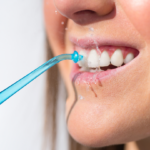
How to Keep Your Teeth Healthy
September 24, 2023
Is Water Flossing Effective?
October 31, 2023Key Takeaways:
Durability and Lifespan:
Dental bonding is an effective treatment for repairing chipped, cracked, or discolored teeth, but it has a relatively shorter lifespan compared to other cosmetic options like veneers.
Procedure Simplicity:
The bonding process is relatively quick and often completed in a single visit. The dentist applies a resin material to the affected tooth, shapes it, and then hardens it using a special light.
Maintenance and Vulnerability:
Although bonding provides a natural-looking solution, it can be more prone to staining, chipping, and wear than natural enamel. Proper oral hygiene is crucial to prolong its effectiveness.
When you need a cosmetic correction for a tooth, dental bonding provides a cost-effective alternative to porcelain veneers. However, you will also want to know more about this option before getting it from your dentist. One of the most common questions about this option is how long does dental bonding last. Find out this and the answers to other common questions about bonding. When you do, you’ll become a better-informed patient and can focus your dental appointment on asking more specific questions about how bonding will work with your case.
What Is Dental Bonding?
Dental bonding provides a way for dentists to correct minor imperfections in the shape of teeth that don’t impact the roots. The resin material used in bonding comes in many colors, and the dentist will select a shade that perfectly matches your teeth. You have a long-lasting repair that covers the cosmetic issues you may have on individual teeth.
Many people want to compare dental bonding to veneers, which also serve a similar purpose. Of the two, bonding costs less and requires less time for placement. However, bonding may not last as long because the resin material used is not as durable as the porcelain used for veneers. You will still enjoy years of your corrected smile with dental bonding.
When Do You Need Dental Bonding?
You may need dental bonding to correct minor cosmetic issues with your teeth. Common issues dentists use bonding to fix include:
- Small chips in teeth
- Individually discolored teeth
- A large gap between a pair of teeth
- Too short teeth
- Misshapen teeth
The above issues typically don’t cause pain because the damage only affects the tooth’s surface. However, you may feel embarrassed to have a complete smile showing off your teeth with these imperfections. Bonding provides a way to help you regain your confidence and feel great about smiling again.
What Is the Process for Getting Dental Bonding?
The process for getting dental bonding is simple and fast. In fact, it often only requires a single dental visit after you and your dentist agree that you need bonding.
First, the dentist will look at your surrounding teeth to find a resin color that matches your mouth. If you want teeth whitening, your bonding material will not respond to the process, so have your teeth whitened before getting bonding to ensure that everything matches.
Next, the dentist needs to prepare your tooth to accommodate the adhesive and bonding. To do this, they will rough the surface of the tooth. However, the impact on the tooth’s enamel is minimal, so your tooth can readily accommodate either veneers or bonding when you need to have the treatment replaced. Or even have the bonding completely removed if you change your mind.
Third, the dentist will apply an adhesive to the tooth and apply the resin on top. To correct your cosmetic concerns, the dentist will shape the resin while it remains pliable.
Once properly shaped, the dentist hardens bonding resin with a special light that also cures the material and provides a lasting fit.
Finally, the dentist will polish the finished tooth, and you will be ready to enjoy your new smile as soon as you leave the office.
How Long Does It Take to Get Dental Bonding Placed?
Dental bonding only requires a single visit. On the other hand, veneers need two visits. The first of these prepares your tooth and creates a mold for the lab. You’ll wait for a lab to create your veneers, which may require two weeks or longer. Once your dentist receives the completed veneer, you’ll need to return to have it placed.
For those who don’t have time to wait or want immediate results, bonding is the better option.
How Long Does Dental Bonding Last?
Ideally, you want your newly improved smile to last as long as possible. Dental bonding can last for three to five years when you may need repairs on it. Some people can wear their bonding for up to 10 years before needing it replaced.
Your dentist may be able to repair minor issues with your bonding, but significant discoloration or damage will require you to have the bonding wholly replaced. At the end of its lifespan, you may choose to have new bonding, switch to a porcelain veneer, or remove the bonding completely. You do not have this many options with veneers.
How to Extend the Longevity of Your Dental Bonding
Bonding has a susceptibility to chipping and staining more than natural teeth. Therefore, you need to maintain good dental care to get the most out of your bonding.
First, brush and floss regularly to prevent food stains and cavities from developing. Regular dental cleanings will also help to keep bonding from staining.
Another way to prevent stains is to pay attention to what you eat and drink. Skip sodas, coffee, tea, and red wine. If you cannot eliminate these teeth-staining drinks, cut back on them and rinse your mouth with water after drinking them. Follow the same plan with berries, tomato products, and other foods that can stain your teeth and bonding.
Because bonding can chip easily, break the habits of chewing on non-food items, such as fingernails, pens, or pencils. Also, avoid eating tough foods, such as hard candies or nuts, with your bonded tooth. Be careful when eating so you don’t accidentally bite down on a bone or fork with your bonding-covered tooth.
Finally, stop using tobacco products. They stain your teeth and any bonding in your mouth, increasing the risks of oral cancer and other health issues.
Get Bonding and Other Cosmetic Dental Services at Langley Dental Care
If you have chips or other imperfections in your smile, see us at Langley Dental Care. We provide our patients with cosmetic, restorative, and preventative dental care. So, whether you need whitening, bonding, or cleaning, we can help. Contact us today and set up your visit with our team.



